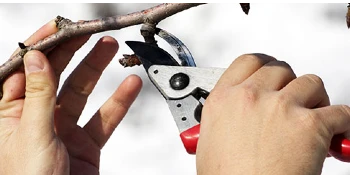How to Prune Dormant Trees

Most people take a break from their job during the summer months in order to take advantage of the warmer weather, but for trees, winter is the prime time for resting. This period of dormancy temporarily slows the growth of the tree, providing a great opportunity for homeowners to perform much needed maintenance with less stress to limbs and foliage. Pruning trees in winter is just one of the many services offered by The Grounds Guys® that will add value to your home, protect your investment, and help save you time and money.
Watch our quick video to see a few different tools and techniques to prune trees and read the full blog post below:
Reasons for Pruning Trees
The action of pruning is used to modify the shape and growth of a plant, and a number of present and future issues can be prevented with professional pruning during the early, formative years of a tree. The reasons behind pruning can include:
Health
Healthy trees can provide you with a lifetime of beauty, shade, fruit, or flowers. Conditions that can have a negative impact on health include:
- Branches that rub together
- Branch stubs which may encourage wood decay
- Dead or dying branches, caused by internal or external sources
Maintenance
Annual maintenance may be needed to ensure the following:
- Dense growth
- Preferred form
- Development of fruit or blooms
Appearance
Pruning should enhance the natural form and beauty of the tree, and for appearances sake should only be used to:
- Maintain natural proportions
- Remove undesirable growth
- Control size and shape
- Increase the curb appeal of your home
Safety
Protect your family, visitors, and property with pruning techniques which include:
- Removing branches which hang over walkways, roof lines, parking spaces, or anywhere they may cause damage or injury if they fall.
- Removal of dead branches
- Creating a clear line of sight to your homes entryway
How to Prune Dormant Trees
Pruning trees in winter or early spring, prior to the start of spring growth, gives the tree adequate time to recover from fresh wounds while minimizing exposure to insects, bacteria, and fungi. Specialized tools and safety equipment are required to minimize the risk of injury to the tree or individuals, and this process is best left to experienced, qualified professionals.
Tools and Safety Equipment
- Saw
- Pole saw
- Pruning shears
- Lopping shears
- Ladder
- Eye protection
- Heavy duty gloves
Pruning Types
- Cleaning - This type of pruning is necessary to remove damaged, dead, or diseased limbs to prevent further damage or injury.
- Raising - Removal of select lower branches to achieve greater clearance for people, vehicles, signage, or lawn maintenance.
- Thinning - Strategic thinning reduces the density of branches to encourage greater air movement and light penetration.
- Reduction - Should only be used as needed to reduce the height or width of the tree. When performed improperly or on a more intolerant species, it can negatively impact the health and integrity of the tree.
Pruning Tips and Techniques
Small branches - To trim a side branch or twig, cut it back to the main branch or make a clean, slanted cut approximately one-quarter inch from the nearest bud.
Large branches - A series of cuts is required to avoid injury to the bark. The first cut should be made from the bottom of the branch, between 18 inches and two feet from the main trunk, and penetrate about one-third of the branch.
The second cut should be made from the top of the branch about an inch further out from the first, cutting through until the branch breaks.
The final cut should be made just past the branch collar, and the area left untouched to promote natural healing.
Contact your local The Grounds Guys franchise for winter tree pruning in your area. For more videos on pruning rose bushes, perennials and more, check out our winter pruning playlist on YouTube.
 Click to call
Click to call


